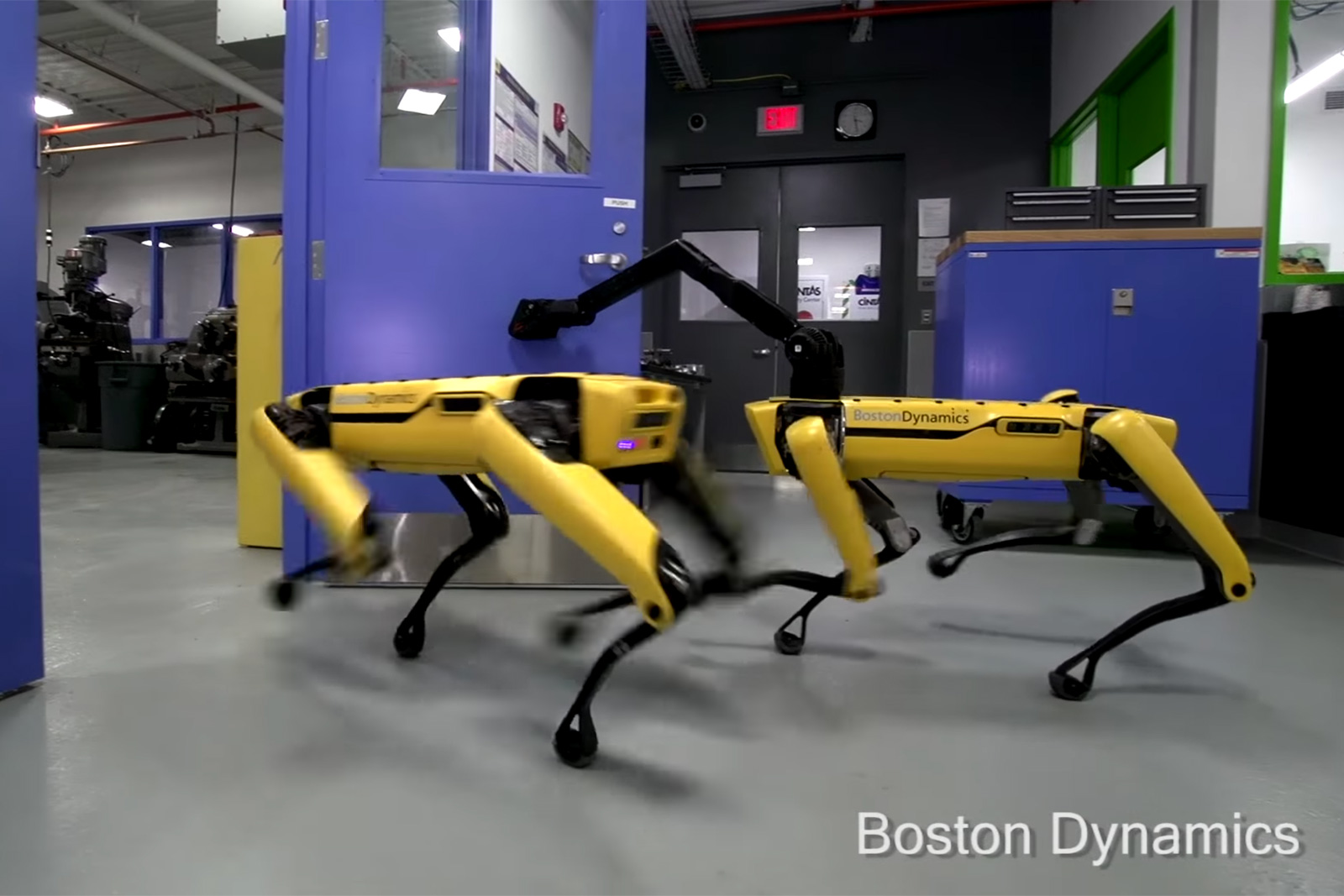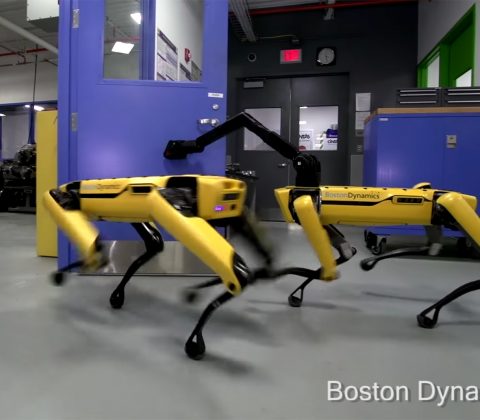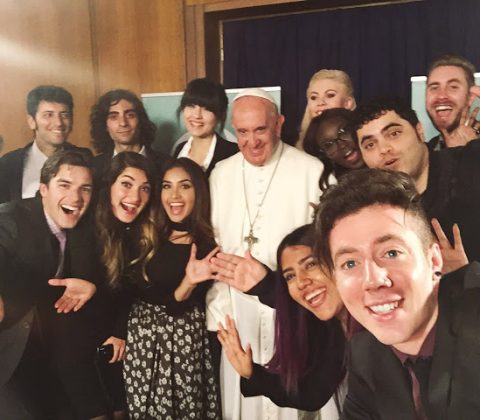Posts Tagged: Meet
Hitting the Books: Meet Richard Akrwright, the world’s first tech titan
You didn’t actually believe all those founder’s myths about tech billionaires like Bezos, Jobs and Musk pulling themselves up by their bootstraps from some suburban American garage, did you? In reality, our corporate kings have been running the same playbook since the 18th century when Lancashire’s own Richard Arkwright wrote it. Arkwright is credited with developing a means of forming cotton fully into thread — technically he didn’t actually invent or design the machine, but developed the overarching system in which it could be run at scale — and spinning that success into financial fortune. Never mind the fact that his 24-hour production lines were operated by boys as young as seven pulling 13-hour shifts.
In Blood in the Machine: The Origins of the Rebellion Against Big Tech — one of the best books I’ve read this year — LA Times tech reporter Brian Merchant lays bare the inhumane cost of capitalism wrought by the industrial revolution and celebrates the workers who stood against those first tides of automation: the Luddites.
Excerpted from Blood in the Machine: The Origins of the Rebellion Against Big Tech by Brian Merchant. Published by Hachette Book Group. Copyright © 2023 by Brian Merchant. All rights reserved.
The first tech titans were not building global information networks or commercial space rockets. They were making yarn and cloth.
A lot of yarn, and a lot of cloth. Like our modern-day titans, they started out as entrepreneurs. But until the nineteenth century, entrepreneurship was not a cultural phenomenon. Businessmen took risks, of course, and undertook novel efforts to increase their profits. Yet there was not a popular conception of the heroic entrepreneur, of the adventuring businessman, until long after the birth of industrial capitalism. The term itself was popularized by Jean-Baptiste Say, in his 1803 work A Treatise on Political Economy. An admirer of Adam Smith’s, Say thought that The Wealth of Nations was missing an account of the individuals who bore the risk of starting new business; he called this figure the entrepreneur, translating it from the French as “adventurer” or “undertaker.”
For a worker, aspiring to entrepreneurship was different than merely seeking upward mobility. The standard path an ambitious, skilled weaver might pursue was to graduate from apprentice to journeyman weaver, who rented a loom or worked in a shop, to owning his own loom, to becoming a master weaver and running a small shop of his own that employed other journeymen. This was customary.
In the eighteenth and nineteenth centuries, as now in the twenty-first century, entrepreneurs saw the opportunity to use technology to disrupt longstanding customs in order to increase efficiencies, output, and personal profit. There were few opportunities for entrepreneurship without some form of automation; control of technologies of production grants its owner a chance to gain advantage or take pay or market share from others. In the past, like now, owners started small businesses at some personal financial risk, whether by taking out a loan to purchase used handlooms and rent a small factory space, or by using inherited capital to procure a steam engine and a host of power looms.
The most ambitious entrepreneurs tapped untested technologies and novel working arrangements, and the most successful irrevocably changed the structure and nature of our daily lives, setting standards that still exist today. The least successful would go bankrupt, then as now.
In the first century of the Industrial Revolution, one entrepreneur looms above the others, and has a strong claim on the mantle of the first of what we’d call a tech titan today. Richard Arkwright was born to a middle-class tailor’s family and originally apprenticed as a barber and wigmaker. He opened a shop in the Lancashire city of Bolton in the 1760s. There, he invented a waterproof dye for the wigs that were in fashion at the time, and traveled the country collecting hair to make them. In his travels across the Midlands, he met spinners and weavers, and became familiar with the machinery they used to make cotton garments. Bolton was right in the middle of the Industrial Revolution’s cotton hub hotspot.
Arkwright took the money he made from the wigs, plus the dowry from his second marriage, and invested it in upgraded spinning machinery. “The improvement of spinning was much in the air, and many men up and down Lancashire were working at it,” Arkwright’s biographer notes. James Hargreaves had invented the spinning jenny, a machine that automated the process of spinning cotton into a weft— halfway into yarn, basically— in 1767. Working with one of his employees, John Kay, Arkwright tweaked the designs to spin cotton entirely into yarn, using water or steam power. Without crediting Kay, Arkwright patented his water frame in 1769 and a carding engine in 1775, and attracted investment from wealthy hosiers in Nottingham to build out his operation. He built his famous water-powered factory in Cromford in 1771.
His real innovation was not the machinery itself; several similar machines had been patented, some before his. His true innovation was creating and successfully implementing the system of modern factory work.
“Arkwright was not the great inventor, nor the technical genius,” as the Oxford economic historian Peter Mathias explains, “but he was the first man to make the new technology of massive machinery and power source work as a system— technical, organizational, commercial— and, as a proof, created the first great personal fortune and received the accolade of a knighthood in the textile industry as an industrialist.” Richard Arkwright Jr., who inherited his business, became the richest commoner in England.
Arkwright père was the first start‑up founder to launch a unicorn company we might say, and the first tech entrepreneur to strike it wildly rich. He did so by marrying the emergent technologies that automated the making of yarn with a relentless new work regime. His legacy is alive today in companies like Amazon, which strive to automate as much of their operations as is financially viable, and to introduce highly surveilled worker-productivity programs.
Often called the grandfather of the factory, Arkwright did not invent the idea of organizing workers into strict shifts to produce goods with maximal efficiency. But he pursued the “manufactory” formation most ruthlessly, and most vividly demonstrated the practice could generate huge profits. Arkwright’s factory system, which was quickly and widely emulated, divided his hundreds of workers into two overlapping thirteen-hour shifts. A bell was rung twice a day, at 5 a.m. and 5 p.m. The gates would shut and work would start an hour later. If a worker was late, they sat the day out, forfeiting that day’s pay. (Employers of the era touted this practice as a positive for workers; it was a more flexible schedule, they said, since employees no longer needed to “give notice” if they couldn’t work. This reasoning is reminiscent of that offered by twenty-first-century on‑demand app companies.) For the first twenty-two years of its operation, the factory was worked around the clock, mostly by boys like Robert Blincoe, some as young as seven years old. At its peak, two-thirds of the 1,100-strong workforce were children. Richard Arkwright Jr. admitted in later testimony that they looked “extremely dissipated, and many of them had seldom more than a few hours of sleep,” though he maintained they were well paid.
The industrialist also built on‑site housing, luring whole families from around the country to come work his frames. He gave them one week’s worth of vacation a year, “but on condition that they could not leave the village.” Today, even our most cutting-edge consumer products are still manufactured in similar conditions, in imposing factories with on‑site dormitories and strictly regimented production processes, by workers who have left home for the job. Companies like Foxconn operate factories where the regimen can be so grueling it has led to suicide epidemics among the workforce.
The strict work schedule and a raft of rules instilled a sense of discipline among the laborers; long, miserable shifts inside the factory walls were the new standard. Previously, of course, similar work was done at home or in small shops, where shifts were not so rigid or enforced.
Arkwright’s “main difficulty,” according to the early business theorist Andrew Ure, did not “lie so much in the invention of a proper mechanism for drawing out and twisting cotton into a continuous thread, as in [. . .] training human beings to renounce their desultory habits of work and to identify themselves with the unvarying regularity of the complex automation.” This was his legacy. “To devise and administer a successful code of factory discipline, suited to the necessities of factory diligence, was the Herculean enterprise, the noble achievement of Arkwright,” Ure continued. “It required, in fact, a man of a Napoleon nerve and ambition to subdue the refractory tempers of workpeople.”
Ure was hardly exaggerating, as many workers did in fact view Arkwright as akin to an invading enemy. When he opened a factory in Chorley, Lancashire, in 1779, a crowd of stockingers and spinners broke in, smashed the machines, and burned the place to the ground. Arkwright did not try to open another mill in Lancashire.
Arkwright also vigorously defended his patents in the legal system. He collected royalties on his water frame and carding engine until 1785, when the court decided that he had not actually invented the machines but had instead copied their parts from other inventors, and threw the patents out. By then, he was astronomically wealthy. Before he died, he would be worth £500,000, or around $ 425 million in today’s dollars, and his son would expand and entrench his factory empire.
The success apparently went to his head— he was considered arrogant, even among his admirers. In fact, arrogance was a key ingredient in his success: he had what Ure described as “fortitude in the face of public opposition.” He was unyielding with critics when they pointed out, say, that he was employing hundreds of children in machine-filled rooms for thirteen hours straight. That for all his innovation, the secret sauce in his groundbreaking success was labor exploitation.
In Arkwright, we see the DNA of those who would attain tech titanhood in the ensuing decades and centuries. Arkwright’s brashness rhymes with that of bullheaded modern tech executives who see virtue in a willingness to ignore regulations and push their workforces to extremes, or who, like Elon Musk, would gleefully wage war with perceived foes on Twitter rather than engage any criticism of how he runs his businesses. Like Steve Jobs, who famously said, “We’ve always been shameless about stealing great ideas,” Arkwright surveyed the technologies of the day, recognized what worked and could be profitable, lifted the ideas, and then put them into action with an unmatched aggression. Like Jeff Bezos, Arkwright hypercharged a new mode of factory work by finding ways to impose discipline and rigidity on his workers, and adapting them to the rhythms of the machine and the dictates of capital— not the other way around.
We can look back at the Industrial Revolution and lament the working conditions, but popular culture still lionizes entrepreneurs cut in the mold of Arkwright, who made a choice to employ thousands of child laborers and to institute a dehumanizing system of factory work to increase revenue and lower costs. We have acclimated to the idea that such exploitation was somehow inevitable, even natural, while casting aspersions on movements like the Luddites as being technophobic for trying to stop it. We forget that working people vehemently opposed such exploitation from the beginning.
Arkwright’s imprint feels familiar to us, in our own era where entrepreneurs loom large. So might a litany of other first-wave tech titans. Take James Watt, the inventor of the steam engine that powered countless factories in industrial England. Once he was confident in his product, much like a latter-day Bill Gates, Watts sold subscriptions for its use. With his partner, Matthew Boulton, Watts installed the engine and then collected annual payments that were structured around how much the customer would save on fuel costs compared to the previous engine. Then, like Gates, Watts would sue anyone he thought had violated his patent, effectively winning himself a monopoly on the trade. The Mises Institute, a libertarian think tank, argues that this had the effect of constraining innovation on the steam engine for thirty years.
Or take William Horsfall or William Cartwright. These were men who were less innovative than relentless in their pursuit of disrupting a previous mode of work as they strove to monopolize a market. (The word innovation, it’s worth noting, carried negative connotations until the mid-twentieth century or so; Edmund Burke famously called the French Revolution “a revolt of innovation.”) They can perhaps be seen as precursors to the likes of Travis Kalanick, the founder of Uber, the pugnacious trampler of the taxi industry. Kalanick’s business idea— that it would be convenient to hail a taxi from your smartphone— was not remarkably inventive. But he had intense levels of self-determination and pugnacity, which helped him overrun the taxi cartels and dozens of cities’ regulatory codes. His attitude was reflected in Uber’s treatment of its drivers, who, the company insists, are not employees but independent contractors, and in the endemic culture of harassment and mistreatment of the women on staff.
These are extreme examples, perhaps. But to disrupt long-held norms for the promise of extreme rewards, entrepreneurs often pursue extreme actions. Like the mill bosses who shattered 19th-century standards by automating cloth-making, today’s start‑up founders aim to disrupt one job category after another with gig work platforms or artificial intelligence, and encourage others to follow their lead. There’s a reason Arkwright and his factories were both emulated and feared. Even two centuries later, many tech titans still are.
This article originally appeared on Engadget at https://www.engadget.com/hitting-the-books-blood-in-the-machine-brian-merchant-hachette-book-group-143056410.html?src=rss
Engadget is a web magazine with obsessive daily coverage of everything new in gadgets and consumer electronics
Meet Samsung’s new Galaxy Tab S9 series with Snapdragon 8 Gen 2 power and AMOLED displays throughout
Next up in today’s deluge of new Samsung devices is the Galaxy Tab S9 series which consists of the Tab S9, Tab S9+, and the gargantuan Tab S9 Ultra. All three models are powered by Qualcomm’s Snapdragon 8 Gen 2 chipset and boast AMOLED displays throughout, including the Tab S9. As the latest in Samsung’s […]
Come comment on this article: Meet Samsung’s new Galaxy Tab S9 series with Snapdragon 8 Gen 2 power and AMOLED displays throughout
Meet the game-changing pitching robot that can perfectly mimic any human throw
Trajekt’s high-tech pitching machine can mimic the exact speed, spin, and trajectory of any human pitch. It’s a literal game-changer for professional baseball
Digital Trends
The Google Meet and Duo transition is going just as poorly as you’d expect
Earlier this year, Google began merging its Duo and Meet platforms together. Now, the Duo app icon is back… only to redirect people to Meet. Oh boy.
Android | Digital Trends
‘Allo’ beckons to Google Duo from the graveyard as Google Meet gets ready to take its place
In this latest example of Google’s complicated rebranding fetish, the Duo app is set to be incorporated into the Google Meet app, with notifications of “Duo is getting even better” being sent out. This rebranding means that Duo will get all of Google Meet’s features before the two apps become one app which will be […]
Come comment on this article: ‘Allo’ beckons to Google Duo from the graveyard as Google Meet gets ready to take its place
Meet Motorola’s refreshed Moto G Stylus 5G and Moto G 5G handsets – one has NFC, the other doesn’t
Motorola is back with yet another pair of mid-range phones, this time in the guise of the Moto G 5G and the Moto G Stylus 5G. We’ve got the details for you after the break but let me whet your appetite right now with the news that one of the two phones actually supports NFC […]
Come comment on this article: Meet Motorola’s refreshed Moto G Stylus 5G and Moto G 5G handsets – one has NFC, the other doesn’t
Meet Tronsmart’s Bang 60W speaker with a built-in Light Show, Power Bank, and Dual Woofers for $110
If it’s a portable outdoor speaker you are on the hunt for then Tronsmart’s Bang 60W Speaker could be just what you need to become the life of the party. Sporting 60W of audio power thanks to its dual tweeters and woofers, the Bang 60W also packs in Bluetooth and NFC for seamless connectivity along […]
Come comment on this article: Meet Tronsmart’s Bang 60W speaker with a built-in Light Show, Power Bank, and Dual Woofers for $ 110
Google has introduced Meet for Chromecast, which is already being deployed to devices around the world
Google has introduced Meet for Chromecast, and it’s already started being rolled out to Chromecast devices. The new feature should be deployed to all Chromecast devices around the world by the end of the week. The Google Chromecast team announced the introduction of the new feature via Google’s support pages, explaining the news follows the […]
Come comment on this article: Google has introduced Meet for Chromecast, which is already being deployed to devices around the world
Google Meet comes to TVs thanks to Chromecast
After taking countless video calls throughout the coronavirus pandemic, you're probably at the point where you want to mix things up a bit. Now you can with Google Meet. Google has started rolling out an update for Meet that allows the software to ca…
Engadget RSS Feed
Meet the Huawei Watch GT 2 (with up to two weeks of battery life)
Alongside the Mate 30 Pro, Huawei also announced the Watch GT 2. We were expecting this watch from some previous leaks, but there were some things that still surprised us. The watch is running LiteOS instead of HarmonyOS, for example, and Huawei claims it can deliver up to 14 days of battery life, which is […]
Come comment on this article: Meet the Huawei Watch GT 2 (with up to two weeks of battery life)
LG’s take a folding phone is a little too weird; meet the LG G8X
I know what you’re thinking: “man, I really do like the sound of the LG G8 ThinQ, but I really wish it had two identical screens on a hinge!” Right? No? Well, that’s LG’s next idea anyway. Meet the LG G8X, the company’s take on a folding device that’s not quite like what we’ve seen […]
Come comment on this article: LG’s take a folding phone is a little too weird; meet the LG G8X


Meet the 2018 Creators for Change Global Ambassadors
Today, we welcome 47 incredible creators to the YouTube Creators for Change program as the 2018 class of Ambassadors. This global initiative, which we kicked off in 2016, spotlights inspirational creators who use YouTube’s global reach to change conversations around tough issues and make a truly positive impact on the world. Chosen for their passion and dedication to creating social change, these YouTube creators come from over 16 countries and represent a combined audience of 20 million fans:
The 2018 class features 31 new creators as well as 16 creators from last year’s program (those returning are distinguished with a *):
- [Australia] L-FRESH the LION*, Sarah Grimstone
- [Brazil] Nátaly Neri, Muro Pequeno
- [Canada] Rossana from Eh Bee Family, AsapSCIENCE
- [France] Swann Périssé*, HugoDecrypte, Lea Camilleri
- [Germany] MaximNoise, Datteltäter*, ImJette*, Diana zur Löwen
- [India] MostlySane, Girliyapa, Niharika Nim*
- [Indonesia] Gita Devi*, Jovi Hunter*, Film Maker Muslim*, Cameo Project*, Duo Harbatah
- [Malaysia] The MingThing
- [MENA] Fly With Haifa, Maha AJ*, Shog AL Maskery*, Muaz Osman, Omar Farooq, Raneem Al Muhandis
- [Mexico] Victoria Volkóva
- [Philippines] Janina Vela
- [Singapore] Ministry of Funny
- [Thailand] Picnicly
- [Turkey] İlker Gümüşoluk*
- [United Kingdom] Humza*, Jazza John, SuperSamStuff*, Riyadh K, BENI*, Fun for Louis, Myles Dyer*, MyPaleSkin
- [United States] Jouelzy, Yasmany Del Real, Beleaf in Fatherhood, Subhi Taha*, Jubilee Media, Hallease
As part of our $ 5M investment in this program, these creators will receive support from YouTube through a combination of project funding, mentorship opportunities, and ongoing production assistance at our YouTube Spaces. They’ll also join us for our second annual Social Impact Camp at YouTube Space London this summer. The Social Impact Camp is an exclusive two-day-long camp featuring inspirational speakers, video production workshops, and mentorship opportunities with experts as well as time for the Ambassadors to connect with one another.
We’re also joining forces with the United Nations Development Programme (UNDP) and social change agency Love Frankie to support YouTube creators from the Asia-Pacific region who are passionate about creating social impact and tackling tough issues through their videos. First up for this new partnership will be a series of Boot Camps in Australia, Indonesia, Malaysia, Philippines and Thailand between June – November 2018 where local creators will workshop creating content about local issues alongside experts such as NGOs, academic authorities, and subject matter specialists. Following these Boot Camps, select local creators will participate in a three-month Academy Program that includes mentoring from Creators for Change Ambassadors, local experts, and NGOs to help produce informed, high-quality content that resonates in their countries.
Over the next few months, the 2018 Creators for Change Ambassadors will kick off projects addressing hate speech, xenophobia and/or extremism through different creative forms, such as a series celebrating the Black community within Brazil and a video project that creates awareness about the negative impact that hate speech can have on mental and physical well-being. There are many more incredible ideas in the works — we can’t wait to share more from these inspiring YouTube role models soon.
To the creators who are joining us as 2018 Ambassadors: thank you. We’re humbled to be working with you on sharing your messages of hope and tolerance.
— Juniper Downs, Head of YouTube Public Policy


Trump will meet with video game industry leaders on March 8th
 After a little bit of back and forth, it appears that the White House's meeting with the video game industry is on. At today's press briefing, White House press secretary Sarah Huckabee Sanders confirmed that a meeting will take place this Thursday,…
After a little bit of back and forth, it appears that the White House's meeting with the video game industry is on. At today's press briefing, White House press secretary Sarah Huckabee Sanders confirmed that a meeting will take place this Thursday,…
Engadget RSS Feed


Boston Dynamics’ robots are the politest ‘pets’ you’ll meet
 We hope you weren't planning on sleeping tonight. Boston Dynamics has posted a video showing that its SpotMini robot can hold the door open for its fellow automatons. If one bot needs a helping hand, it'll signal to another machine nearby that can…
We hope you weren't planning on sleeping tonight. Boston Dynamics has posted a video showing that its SpotMini robot can hold the door open for its fellow automatons. If one bot needs a helping hand, it'll signal to another machine nearby that can…
Engadget RSS Feed


Recommended Reading: Meet the attorney who’s fighting revenge porn
 The Attorney Fighting Revenge Porn Margaret Talbot, The New Yorker Carrie Goldberg started her practice to "be the lawyer" she needed after being harassed online by an ex. Now she's a pioneer is dealing with revenge porn cases, defending victims a…
The Attorney Fighting Revenge Porn Margaret Talbot, The New Yorker Carrie Goldberg started her practice to "be the lawyer" she needed after being harassed online by an ex. Now she's a pioneer is dealing with revenge porn cases, defending victims a…
Engadget RSS Feed
Meet Boston Dynamics’ eclectic lineup of innovative (and peculiar) robots
Boston Dynamics has become famous thanks to videos of its eclectic, animal-like robots. It’s made so many robots over the years that it’s hard to keep them all straight. Here’s our roundup of Boston Dynamics’ memorable creations.
The post Meet Boston Dynamics’ eclectic lineup of innovative (and peculiar) robots appeared first on Digital Trends.
Meet Vi, the AI-based personal trainer that lives in your headphones
Meet Vi, heralded as a first-of-its-kind AI personal trainer, whose recently launched Kickstarter campaign has already blown past its initial funding goal of $ 100,000. Contained in a set of high-tech headphones, Vi is a new kind of wearable
The post Meet Vi, the AI-based personal trainer that lives in your headphones appeared first on Digital Trends.


YouTube creators meet Pope Francis to discuss promoting understanding and empathy
YouTube has helped millions of people see that we have a lot in common, despite our differences. Building these bridges can start with a simple conversation, and over the past 11 years, we’ve seen YouTube creators use the power of video to do just that. From Hayla Ghazal encouraging women in the Middle East and around the world to speak up, to Dulce Candy sharing her own story as an undocumented immigrant and military veteran, creators from around the world have used our platform to express themselves, encourage new perspectives, and inspire solidarity within global fan bases.
We want to continue empowering people to come to YouTube to tell stories and form connections that encourage empathy and understanding between diverse communities.
That’s why today 11 international YouTube creators met with Pope Francis, who cares deeply about bringing young people together. This first-of-its-kind dialogue took place during the VI Scholas World Congress, which the Pope created to encourage peace through real encounters with youth from different backgrounds.
The YouTube creators who participated in this conversation represent more than 27 million subscribers globally. They come from ten different countries and diverse religious backgrounds: Louise Pentland (United Kingdom), Lucas Castel (Argentina), Matemática Río (Brazil), Hayla Ghazal (United Arab Emirates), Dulce Candy (United States), Matthew Patrick (United States), Jamie and Nikki (Australia and Sudan/Egypt), Greta Menchi (Italy), Los Polinesios (Mexico) and anna RF (Israel).
During the conversation with the Pope, these creators raised topics that they are passionate about as role models, including immigrant rights, gender equality, loneliness and self-esteem, and greater respect for diversity of all kinds.
We’re inspired by the many conversations these creators have sparked throughout their YouTube journeys. To hear more about what they discussed at the Vatican today, tune in to each of their channels for personal videos in the coming weeks. We hope to continue helping people share their stories – the more we can all understand, the more we can come together as a global community.
Juniper Downs, Head of Policy for YouTube, recently watched “I am a Muslim, hug me if you trust me.”
Meet the InFocus Bingo 10, the world’s cheapest Marshmallow smartphone
U.S.-based InFocus unveiled the Bingo 10, the newest addition to its smartphone lineup that claims to be the world’s cheapest smartphone running Android 6.0 Marshmallow. The phone is only available in India.
The post Meet the InFocus Bingo 10, the world’s cheapest Marshmallow smartphone appeared first on Digital Trends.


Meet the world’s smallest camera-equipped drone
 The Axis Vidius is a quadcopter that fits in the palm of your hand — it's roughly 1.5 inches square — yet it's able to livestream and record video in 420p. Axis says its Vidius model is the smallest-ever camera-equipped drone, and it's so tiny that…
The Axis Vidius is a quadcopter that fits in the palm of your hand — it's roughly 1.5 inches square — yet it's able to livestream and record video in 420p. Axis says its Vidius model is the smallest-ever camera-equipped drone, and it's so tiny that…
Engadget RSS Feed
Meet YouTube Red, the ultimate YouTube experience
For years, YouTube’s fans have been telling us they want more—more choice when watching their favorite content, more ways to support their favorite creators and, above all, the option to watch their favorite videos uninterrupted.
On October 28, we’re giving fans exactly what they want. Introducing YouTube Red — a new membership designed to provide you with the ultimate YouTube experience.
YouTube Red lets you enjoy videos across all of YouTube without ads, while also letting you save videos to watch offline on your phone or tablet and play videos in the background, all for $ 9.99 a month. Your membership extends across devices and anywhere you sign into YouTube, including our recently launched Gaming app and a brand new YouTube Music app we’re announcing today that will be available soon.
YouTube Music is designed to make discovering, watching and listening to music easier than ever. Any song or artist you choose on YouTube Music will start you on a personal journey through one of the richest music catalogs; just sign in, tap a track you love, and see where your music takes you. And as a special bonus – YouTube Red works with Google Play Music, so subscribe to one and automatically get access to the other.
And starting early next year, YouTube Red will get even better with member-only access to new, original shows and movies from some of YouTube’s biggest creators. You can read all about Originals coming to YouTube Red here.
We’re working to bring YouTube Red and our YouTube Music, Gaming and Kids apps to more countries soon. And don’t worry! The free, ad-supported version of YouTube we all know and love isn’t going anywhere. You’ll still be able to enjoy YouTube, along with the YouTube Kids, Gaming and Music apps free of charge. But with YouTube Red, you’ll be able to support the people who make your favorite videos while watching what you want, when you want, on any device you want, uninterrupted.
Viewers in the U.S. can try YouTube Red for free with a one month trial on October 28 and YouTube Music will be coming soon.
Matt Leske, Senior Product Manager, recently watched “The Juice Challenge.”


